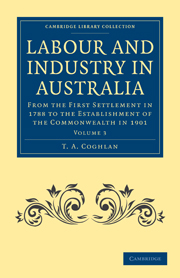 Labour and Industry in Australia
Labour and Industry in Australia Book contents
Summary
The most important feature of the period from an economic point of view was the great fall in prices which took place in 1885 and persisted almost unchecked during the succeeding ten years. Taking the whole produce of Australia, there was a fall of about 14 per cent in prices from 1873 to 1877; thereafter they remained stable for about eight years, but in 1885 there was a drop of 12 per cent, to a level which was maintained for four years, when there was another rapid decline. The lowest point was reached in 1894, the average of that year being 32 per cent below that of 1886—89, and 47 per cent below that of the opening years, of the period.
From 1873 to 1888 the movement in prices, although downward, could hardly be said to have been injurious to the Australian communities, as the decline in the price of the produce of the colonies was accompanied by an equal, if not greater, fall in the price of the imported goods for which they were exchanged; but after the year last named the prices of the imports did not fall away nearly as rapidly as those of the exports, the decline from 1888 to 1894 being only about 12½ per cent compared with 32 per cent in the exports. A right appreciation of this price movement is necessary, in order to understand the astonishing economic disturbances by which the period was marked.
- Type
- Chapter
- Information
- Labour and Industry in AustraliaFrom the First Settlement in 1788 to the Establishment of the Commonwealth in 1901, pp. 1608 - 1632Publisher: Cambridge University PressPrint publication year: 2011First published in: 1918
